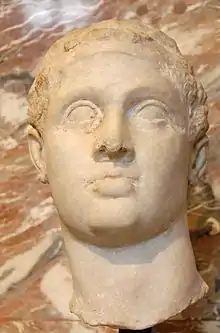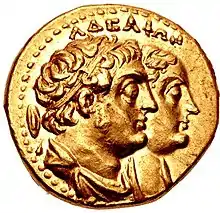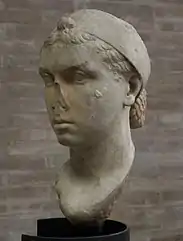Early life of Cleopatra
The early life of Cleopatra VII (r. 51 – 10 or 12 August 30 BC)[note 1] of Ptolemaic Egypt began with her birth in early 69 BC to reigning pharaoh Ptolemy XII Auletes and an unknown mother (possibly Cleopatra V), and lasted until her accession to the throne by March 51 BC. During her early childhood, Cleopatra was brought up in the palace of Alexandria in Egypt and received a primarily-Hellenistic Greek education from her tutor, Philostratos. By adulthood she was well-versed in many languages, including Egyptian, Ethiopian, Hebrew, Arabic, Median, Parthian, Latin, and her native Koine Greek.
 |
| Part of a series on |
| Cleopatra VII |
|---|
Cleopatra's father was a client ruler of the Roman Republic. When the Romans annexed Cyprus and drove Ptolemy XII's brother Ptolemy of Cyprus to commit suicide rather than go into exile, Ptolemy XII became unpopular with the masses in Egypt for remaining silent and offering no reaction to the events. He and a daughter, ostensibly Cleopatra and not Arsinoe IV, were exiled from Egypt during a revolt. This allowed Cleopatra's older sister Berenice IV to claim the throne in 58 BC, ruling jointly with her mother Cleopatra VI Tryphaena. Ptolemy XII and Cleopatra traveled first to Roman Italy. In the Alban Hills (outside Rome), they stayed at the villa of their Roman patron, the triumvir Pompey the Great. After Ptolemy XII orchestrated the assassinations of Berenice IV's diplomats in Rome, seeking to gain Roman favor, he and Cleopatra left the city's hostile environment and settled at Ephesus in Anatolia.
Pompey eventually convinced Aulus Gabinius, the Roman governor of Syria, to invade Egypt and restore Ptolemy XII to power. In the spring of 55 BC, Gabinius' invasion force arrived. His officer Mark Antony prevented Ptolemy XII from massacring the inhabitants of Pelousion for their defiance, and rescued the body of Archelaos (Berenice's husband) after he was killed in battle. Although Antony said years later that it was then that he fell in love with Cleopatra, their affair did not begin until 41 BC. Ptolemy XII made Cleopatra his regent and joint ruler in 52 BC, naming her and his son (Ptolemy XIII) joint successors in his will and testament. Ptolemy XII died by 22 March 51 BC, the date of Cleopatra's first known act as queen: restoring the sacred Buchis bull in Hermonthis, Egypt. She may have married her brother, Ptolemy XIII, but it is uncertain if they married before engaging in open hostilities against one another.
Birth and tutelage

Cleopatra VII was born in early 69 BC to Ptolemaic pharaoh Ptolemy XII Auletes and an unknown mother,[9] presumably Ptolemy XII's sister-wife Cleopatra VI Tryphaena, also known as Cleopatra V Tryphaena[10][11][12][note 2][note 3]—mother of Cleopatra's older sister, Berenice IV.[13][14][15][note 4] Ptolemy XII was given the epithet "Auletes" ("the flute-player") due to his adoption of the title "New Dionysos" and his reported flute-playing during the Dionysian festivals.[16][17][18][note 5] He had a reputation as an aloof monarch who enjoyed a life of luxury while causing dynastic troubles with the expulsion of Cleopatra VI from the court in late 69 BC (a few months after the birth of Cleopatra VII).[19][20] His three younger children (Cleopatra's sister Arsinoe IV and brothers Ptolemy XIII and Ptolemy XIV)[13][14][15] were born during the more than decade-long absence of his wife.[21][22]
Her childhood tutor was Philostratos, from whom she learned the Greek arts of oration and philosophy.[23][24] During her youth Cleopatra presumably studied at the Musaeum (including the Library of Alexandria), and wrote Greek medical works which may have been inspired by the physicians at her father's royal court.[25][24] Available to her in historical records preserved by the 3rd-century BC Ptolemaic-era native Egyptian historian Manetho were examples of strong, inspirational royal female predecessors (some of whom lived long before the Ptolemaic dynasty), such as Sobekneferu, Hatshepsut, and Nefertiti.[26]
Ptolemaic pharaohs were crowned by Egyptian priests of Ptah at Memphis but resided in the multicultural and largely-Greek city of Alexandria, founded by Alexander the Great of Macedon.[27][28][29][note 6] They spoke Greek and governed Egypt as Hellenistic Greek monarchs, refusing to learn the native Egyptian language.[30][31][32][note 7] Cleopatra could understand and speak many languages by adulthood, including Egyptian, Ethiopian, Trogodyte, Hebrew (or Aramaic), Arabic, Syrian (perhaps Syriac), Median, Parthian, and Latin, although her Roman colleagues would have preferred to speak with her in her native Koine Greek.[33][32][34][note 8] Aside from Greek, Egyptian, and Latin, the three languages she had a known ability to read and write in,[35] these languages reflected Cleopatra's expansionist territorial ambitions and her desire to regain African and Asian territories which had belonged to the Ptolemaic Empire.[36]
Although Egyptians were the dominant ethnic group in Cleopatra's kingdom, large minorities of Greeks, Jews, Celtic and Germanic peoples, Syrians, Nubians, and others inhabited Egypt during her reign and well before it.[37][38] Greeks and Jews were primarily concentrated in the multicultural cities of Alexandria, the old colony of Naukratis, and Ptolemais Hermiou (near Thebes in Upper Egypt).[39][note 9] Greeks, Jews, and Egyptians in these cities were legally segregated, living in different areas and forbidden to intermarry.[40][note 10] The native Egyptian priesthood received a number of privileges and became extremely wealthy under their Ptolemaic patrons, often becoming targets of native Egyptian revolts.[41] Although there were laws against intermarriage in the Greek city-states (poleis) of Egypt, intermarriage was permitted in other parts of Egypt;[42] Cleopatra is speculated to have had an Egyptian half-cousin, Pasherienptah III, the High Priest of Ptah at Memphis.[43] At the beginning of her reign Cleopatra sought the support and loyalty of the Egyptian priesthood, despite attempts by her rival brother and erstwhile co-ruler Ptolemy XIII to undermine this relationship.[44]
Reign of Ptolemy XII and Roman interventionism

Roman interventionism in Egypt predated the reign of Cleopatra VII.[47][48][49] In 168 BC, after Antiochus IV invaded Ptolemaic Egypt, he obeyed the demands of the Roman Senate to withdraw and return to Seleucid territory instead of warring with the Roman Republic.[48][50] When Ptolemy IX Lathyros died in late 81 BC, he was succeeded by his daughter Berenice III.[51][52] With opposition building at the royal court against the idea of a sole female monarch, Berenice III accepted joint rule and marriage to Ptolemy XI Alexander II, the son of Ptolemy IX's brother Ptolemy X Alexander I. The match was arranged by the dictator Sulla, the first powerful Roman figure to intervene directly in the dynastic affairs of kingdoms east of the Roman Republic.[51][52]
Ptolemy XI had his cousin-wife killed shortly after their marriage in 80 BC, but he was killed soon thereafter in the resulting riot over the assassination.[51][53][54] Ptolemy XI (and perhaps his uncle Ptolemy IX or his father) willed the Ptolemaic Kingdom to Rome as collateral for loans, so the Romans had legal grounds to take over Egypt (their client state).[51][17][55] They chose instead to carve up the Ptolemaic realm to be ruled by Ptolemy IX's two illegitimate sons, bestowing Cyprus to Ptolemy of Cyprus and Egypt to Ptolemy XII.[51][53]
In 65 BC the Roman censor Marcus Licinius Crassus argued before the Roman Senate that Ptolemaic Egypt should be annexed (perhaps based on the previous will in exchange for loans), but his proposed bill was scuttled by Cicero's rhetoric.[56] This was followed by another failed proposal for annexation by tribune Servilius Rullus in 63 BC.[57] Ptolemy XII responded to the threatened Roman annexation of Egypt by offering lavish gifts to powerful Roman statesmen and military commanders, such as Pompey the Great (during his campaign against Mithridates VI of Pontus in the Third Mithridatic War) and Julius Caesar after the latter became consul in 59 BC.[58][59][55][note 11]
After Crassus, Pompey, and Caesar formed the alliance of the First Triumvirate in 60 BC, they gave Ptolemy XII the title of "friend and ally of the Roman people" for his efforts in financing Pompey's eastern campaigns and Rome's conquests of West Asian territories which had belonged to the Seleucid Empire.[60][61] The title cost 6,000 talents, nearly the entire annual tax revenue of Ptolemaic Egypt.[62][63][note 12] Ptolemy XII's profligate behavior bankrupted him, and he was forced to acquire loans from Roman banker Gaius Rabirius Postumus.[64][65][62][note 13] His increase of the tax rate to pay for these expenditures angered the poor and led to strikes by farmers.[64][65]
Exile of Ptolemy XII and Cleopatra

In 58 BC, after Roman senator Publius Clodius Pulcher accused Ptolemy XII's brother (Ptolemy of Cyprus) of aiding pirates who disrupted Roman shipping, the Roman Republic annexed Cyprus and drove Ptolemy of Cyprus, where he committed suicide rather than face exile to Paphos as a priest of Apollo.[67][68][62][note 14] Ptolemy XII remained publicly silent on the death of his brother, a decision which (along with ceding traditional Ptolemaic territory to the Romans) damaged his credibility among subjects already enraged by his economic policies.[67][69][70] Whether by force or voluntary action, Ptolemy XII left Egypt in exile to Rhodes and his Roman host, Cato the Younger, who castigated him for losing his kingdom while seated on a latrine and undergoing laxative treatment.[67][71][72][note 15] Ptolemy XII then traveled to Athens, where he erected a monument in honor of his father and half-sister (Berenice III), and finally to the triumvir Pompey's villa in the Alban Hills near Praeneste.[67][73][74][note 16] Ptolemy XII spent nearly a year on the outskirts of Rome, ostensibly accompanied by his 11-year-old daughter Cleopatra.[67][62] Joann Fletcher expresses little doubt about this, noting an ancient Greek primary source stating that Ptolemy XII traveled with one of his daughters; since Berenice IV was his ruling rival and Arsinoe IV was a toddler, it must have been Cleopatra (who was later made his regent and named his successor in his will).[75]
Events in Egypt are unclear around this time. It is thought that Ptolemy XII's estranged wife, Cleopatra V (or VI) Tryphaena, ruled jointly with Berenice IV before she was ousted by the latter and died at an uncertain date.[76][77][72][note 3] Berenice IV sent an emissary to Rome to advocate for her rule and oppose the reinstatement of her father Ptolemy XII, but Ptolemy used his assassins to kill the emissary (an incident covered up by his powerful Roman supporters).[78][65][79][note 17] When Caesar failed to secure a popular election as Governor-General of Egypt, he settled for a five-year command of Gaul and allowed his rival Pompey to settle the matter of the Egyptian throne.[80] The Roman Senate denied Ptolemy XII the offer of an armed escort and provisions for a return to Egypt, so he decided to leave Rome in late 57 BC for the Temple of Artemis at Ephesus.[81][82][83]
Return to Egypt from exile
.jpg.webp)
To shore up her legitimacy with her subjects, Berenice IV married Archelaos (reportedly a descendant of Mithridates VI of Pontus); however, the Romans— especially desperate financiers of Ptolemy XII such as Rabirius Postumus—were determined to restore Ptolemy XII.[88] Pompey persuaded the Roman governor of Syria Aulus Gabinius to invade Egypt and restore Ptolemy XII, offering him 10,000 talents for the mission.[88][73][89][note 19] Although it put him at odds with Roman law, Gabinius invaded Egypt in the spring of 55 BC by way of Hasmonean Judea; Hyrcanus II had Antipater the Idumaean, the father of Herod the Great, furnish the Roman-led army with supplies.[88][69] Under Gabinius' command was the young cavalry officer Mark Antony, who distinguished himself by preventing Ptolemy XII from massacring the inhabitants of Pelousion and rescuing the body of Archelaos after the latter was killed in another battle (ensuring him a royal burial).[90][91][92] The 14-year-old Cleopatra would have accompanied the Roman expedition into Egypt; years later, Mark Antony said that he had fallen in love with her at this time.[90][93][89] Their affair only began 41 BC, when the triumvir Antony summoned Cleopatra to his headquarters at Tarsos to answer for her alleged support of Gaius Cassius Longinus in the Liberators' civil war of 43–42 BC.[94][95]
Gabinius was tried (and acquitted) in Rome for abusing his authority, but his second trial (for accepting bribes) led to a seven-year exile from which he was recalled in 48 BC by Julius Caesar.[96][97] Crassus replaced him as governor of Syria, extending his provincial command to Egypt until he was killed by the Parthians in the 53 BC Battle of Carrhae.[96][98] Ptolemy XII had his rival daughter Berenice and her wealthy supporters executed, seizing their properties and allowing the Gabiniani (Gabinius' largely-Germanic and Gallic Roman garrison) to harass people in the streets of Alexandria.[99][100][101][note 20] He installed his longtime Roman financier, Rabirius Postumus, as his chief financial officer.[99][102][103] Postumus was unable to collect all of Ptolemy XII's debt by the latter's death and it was passed on to his successors, Cleopatra VII and Ptolemy XIII.[104][97] Within a year, Postumus was placed under protective custody and sent back to Rome when his life was threatened for draining Egypt of its resources.[104][105][101][note 21]
During the last four years of his reign, Ptolemy XII (who died of natural causes) designated Cleopatra VII and Ptolemy XIII as his heirs, oversaw major construction projects such as the completion of the Temple of Edfu and establishment of the Dendera Temple, and stabilized an economy largely reliant on trade with East Africa and India.[106][105][103][note 22] A copy of his will was sent to Pompey to be kept in Rome, and the original was held in Alexandria for safekeeping.[105][107][108] According to an inscription in the Temple of Hathor at Dendera, Cleopatra was made a regent of Ptolemy XII on 31 May 52 BC.[109][110][111][note 23]
Accession to the throne
Ptolemy XII died sometime before 22 March 51 BC, the date of Cleopatra's first known act as queen: her voyage to Hermonthis, near Thebes, to install a new sacred Buchis bull (worshiped as an intermediary for the god Montu in ancient Egyptian religion).[112][113][114][note 24] The Roman Senate was not informed about Ptolemy's death until 30 June or 1 August 51 BC; the news may have been suppressed by Cleopatra until she could secure the throne.[115][116][note 25] Cleopatra probably married her brother, Ptolemy XIII,[98] but the marriage is uncertain.[113] The incestuous Ptolemaic practice of sibling marriage was introduced by Ptolemy II and his sister, Arsinoe II, but the long-held royal Egyptian practice was considered scandalous by contemporary Greeks.[45][46][117] Although vocal critics of this incestuous practice were sometimes violently punished and suppressed during the joint reign of Ptolemy II and Arsinoe II,[note 26] sibling marriages were nevertheless considered a normal arrangement for Ptolemaic rulers by the time of Cleopatra's reign.[45][46][117] Official documents began listing Cleopatra as sole ruler by 29 August 51 BC, evidence that she had rejected her brother as a co-ruler.[118][119][120]
See also
- Amanirenas (contemporary queen of Kush who fought a war against the Romans in Egypt and Nubia)
- Death of Cleopatra
- List of cultural depictions of Cleopatra
- Reign of Cleopatra VII
Notes
- Theodore Cressy Skeat, in Skeat 1953, pp. 98–100, uses historical data to calculate the death of Cleopatra as having occurred on 12 August 30 BC. Burstein 2004, p. 31 provides the same date as Skeat, while Dodson & Hilton 2004, p. 277 tepidly support this, saying it occurred circa that date. Those in favor of claiming her death occurred on 10 August 30 BC include Roller 2010, pp. 147–148, Fletcher 2008, p. 3, and Anderson 2003, p. 56.
- For further information and validation see Schiff (2011, p. 28) and Kleiner (2005, p. 22). For alternate speculation, see Burstein (2004, p. 11) and Roller (2010, pp. 15, 18, 166).
- Grant 1972, pp. 3–4, 17, Fletcher 2008, p. 69, Jones 2006, p. xiii and Burstein 2004, p. 11 label the wife of Ptolemy XII Auletes as Cleopatra V Tryphaena, while Dodson & Hilton 2004, pp. 268–269, 273 and Roller 2010, p. 18 call her Cleopatra VI Tryphaena, due to the confusion in primary sources conflating these two figures, who may have been one in the same. As explained by Whitehorne 1994, p. 182, Cleopatra VI may have actually been a daughter of Ptolemy XII, who appeared in 58 BC to jointly-rule with her alleged sister Berenice IV (while Ptolemy XII was exiled and living in Rome), whereas Ptolemy XII's wife Cleopatra V perhaps died as early as the winter of 69–68 BC, when she disappears from historical records. Roller 2010, pp. 18–19 assumes that Ptolemy XII's wife, who he numbers as Cleopatra VI, was merely absent from the court for a decade after being expelled for an unknown reason, eventually ruling jointly with her daughter Berenice IV. Fletcher 2008, p. 76 explains that the Alexandrians deposed Ptolemy XII Auletes and installed "his eldest daughter, Berenike IV, and as co-ruler recalled Cleopatra V Tryphaena from 10 years' exile from the court. Although later historians assumed she must have been another of Auletes' daughters and numbered her "Cleopatra VI", it seems she was simply the fifth one returning to replace her brother and former husband Auletes."
- Due to discrepancies in academic works, in which some consider Cleopatra VI to be either a daughter of Ptolemy XII or his wife, identical to that of Cleopatra V, Jones 2006, p. 28 states that Ptolemy XII had six children, while Roller 2010, p. 16 mentions only five.
- For further information and validation, see Grant 1972, p. 3 and Jones 2006, p. 28.
- For a thorough explanation about the foundation of Alexandria by Alexander the Great and its largely Hellenistic Greek nature during the Ptolemaic period, along with a survey of the various ethnic groups residing there, see Burstein 2004, pp. 43–61.
For further validation about the founding of Alexandria by Alexander the Great, see Jones 2006, p. 6. - The rulers of the Ptolemaic dynasty refused to speak Late Egyptian, which is the reason that ancient Greek (i.e. Koine Greek) as well as Late Egyptian were used on official court documents such as the Rosetta Stone: "Radio 4 Programmes – A History of the World in 100 Objects, Empire Builders (300 BC – 1 AD), Rosetta Stone". BBC. Retrieved 2010-06-07.
- For the list of languages spoken by Cleopatra as mentioned by the ancient historian Plutarch, see Jones 2006, pp. 33–34, which also mentions that the rulers of Ptolemaic Egypt gradually abandoned the Ancient Macedonian language. For further information, see Grant 1972, pp. 20, 256 footnote 42.
- As explained by Burstein 2004, pp. 53–54, Ptolemaic Alexandria was considered a city-state (i.e. polis) separate from the country of Egypt, with citizenship reserved for Greeks and Ancient Macedonians, but various other ethnic groups resided there, especially the Jews, along with Syrians, Nubians, and others.
- The exception to this rule forbidding intermarriage between Egyptians and Greeks applied to Greeks living outside the mainly-Greek cities of Alexandria, Naukratis, and Ptolemais Hermiou. As explained by Burstein 2004, p. 50: "Except for the inhabitants of Alexandria, Naukratis, and Ptolemais, most Greek immigrants lived in predominantly Egyptian environments where intermarriage was not uncommon, and few of the traditional political or social institutions of Greek culture existed. For all intents and purposes, therefore, the majority of Greeks in Egypt remained essentially resident aliens who retained the citizenship of their home poleis, as can be seen from the fact that Egyptian Greeks continued to identify themselves by their poleis of origin in public and private documents even after their families had resided in Egypt for several generations. Greeks living in such circumstances tended to assimilate to the social and cultural mores of their non-Greek neighbors and in-laws."
Also, Burstein 2004, pp. 51–52 makes it clear that by Cleopatra's reign, Jews and even upper-class native Egyptians could be legally classified as "Greeks" if they spoke Greek, received a Greek education, labelled their gods with Greek names, and pursued a Greek lifestyle. - For further information, see Grant 1972, pp. 12–13.
- In 1972, Michael Grant calculated that 6,000 talents, the price of Ptolemy XII Auletes' fee for receiving the title "friend and ally of the Roman people" from the triumvirs Pompey the Great and Julius Caesar, would be worth roughly 7 million British pounds or 17 million US dollars, roughly the entire annual tax revenue for Ptolemaic Egypt: Grant 1972, p. 13.
- For further information about the loans acquired by Ptolemy XII from Roman banker Gaius Rabirius Postumus, see Grant 1972, p. 13.
- For political background information on the Roman annexation of Cyprus, a move pushed for in the Roman Senate by Publius Clodius Pulcher, see Grant 1972, pp. 13–14.
- For further information, see Grant 1972, p. 15.
- For further information, see Grant 1972, pp. 15–16.
- For further information, see Grant 1972, p. 16.
- Fletcher 2008, p. 87 describes the painting from Herculaneum further: "Cleopatra's hair was maintained by her highly skilled hairdresser Eiras. Although rather artificial looking wigs set in the traditional tripartite style of long straight hair would have been required for her appearances before her Egyptian subjects, a more practical option for general day-to-day wear was the no-nonsense 'melon hairdo' in which her natural hair was drawn back in sections resembling the lines on a melon and then pinned up in a bun at the back of the head. A trademark style of Arsinoe II and Berenike II, the style had fallen from fashion for almost two centuries until revived by Cleopatra; yet as both traditionalist and innovator, she wore her version without her predecessor's fine head veil. And whereas they had both been blonde like Alexander, Cleopatra may well have been a redhead, judging from the portrait of a flame-haired woman wearing the royal diadem surrounded by Egyptian motifs which has been identified as Cleopatra."
- For further information, see Grant 1972, pp. 16–17.
- For further information on Roman financier Rabirius Postumus as well as the Gabiniani left in Egypt by Aulus Gabinius, see Grant 1972, pp. 18–19.
- For further information, see Grant 1972, p. 18.
- For further information, see Grant 1972, pp. 19–20, 27–29.
- For further information, see Grant 1972, pp. 28–30.
- For further information and validation, see Fletcher 2008, pp. 85–86, 88–92 and Jones 2006, pp. 31, 34–35. Grant 1972, p. 30 indicates that Ptolemy XII could have been alive as late as May, while an ancient Egyptian source affirms he was still ruling with Cleopatra by 15 July 51 BC, although by this point Cleopatra most likely "hushed up her father's death" so that she could consolidate her control of Egypt.
Fletcher 2008, pp. 85–86 states that the partial solar eclipse of 7 March 51 BC marked the death of Ptolemy XII Auletes and accession of Cleopatra to the throne, although she apparently suppressed the news of his death, alerting the Roman Senate to this fact months later in a message they received on 30 June 51 BC. However, Grant 1972, p. 30 claims that the Senate was informed of his death on 1 August 51 BC. - Fletcher 2008, pp. 85–86 states that the partial solar eclipse of 7 March 51 BC marked the death of Ptolemy XII Auletes and accession of Cleopatra to the throne, although she apparently suppressed the news of his death, alerting the Roman Senate to this fact months later in a message they received on 30 June 51 BC. However, Grant 1972, p. 30 claims that the Senate was informed of his death on 1 August 51 BC.
- Pfrommer & Towne-Markus 2001, p. 34 write the following about the sibling marriage of Ptolemy II and Arsinoe II: "Ptolemy Keraunos, who wanted to become king of Macedon...killed Arsinoë's small children in front of her. Now queen without a kingdom, Arsinoë fled to Egypt, where she was welcomed by her full brother Ptolemy II. Not content, however, to spend the rest of her life as a guest at the Ptolemaic court, she had Ptolemy II's wife exiled to Upper Egypt and married him herself around 275 B.C. Though such an incestuous marriage was considered scandalous by the Greeks, it was allowed by Egyptian custom. For that reason the marriage split public opinion into two factions. The loyal side celebrated the couple as a return of the divine marriage of Zeus and Hera, whereas the other side did not refrain from profuse and obscene criticism. One of the most sarcastic commentators, a poet with a very sharp pen, had to flee Alexandria. The unfortunate poet was caught off the shore of Crete by the Ptolemaic navy, put in an iron basket, and drowned. This and similar actions seemingly slowed down vicious criticism."
References
Citations
- Raia & Sebesta (2017).
- Sabino & Gross-Diaz (2016).
- Grout (2017).
- Pina Polo (2013), pp. 184–186.
- Roller (2010), pp. 54, 174–175.
- Hölbl (2001), p. 234.
- Roller (2010), pp. 174–175.
- Roller (2010), p. 18.
- Roller (2010), p. 15.
- Grant (1972), p. 4.
- Preston (2009), p. 22.
- Jones (2006), pp. xiii, 28.
- Roller (2010), p. 16.
- Anderson (2003), p. 38.
- Fletcher (2008), p. 73.
- Roller (2010), pp. 17–18.
- Burstein (2004), p. 12.
- Fletcher (2008), p. 68.
- Roller (2010), pp. 18–19.
- Fletcher (2008), pp. 68–69.
- Roller (2010), p. 19.
- Fletcher (2008), p. 69.
- Roller (2010), pp. 45–46.
- Fletcher (2008), p. 81.
- Roller (2010), p. 45.
- Fletcher (2008), pp. 82–84.
- Roller (2010), pp. 32–33.
- Fletcher (2008), pp. 1, 3, 11, 129.
- Burstein (2004), p. 11.
- Roller (2010), pp. 29–33.
- Fletcher (2008), pp. 1, 5, 13–14, 88, 105–106.
- Burstein (2004), pp. 11–12.
- Roller (2010), pp. 46–48.
- Fletcher (2008), pp. 5, 82, 88, 105–106.
- Roller (2010), pp. 48–49.
- Roller (2010), pp. 46–48, 100.
- Burstein (2004), pp. 13–14, 16–17, 43–52, 54.
- Fletcher (2008), p. 53-54, 80, 121.
- Burstein (2004), p. 47.
- Burstein (2004), pp. 47–50.
- Burstein (2004), pp. 48–49.
- Burstein (2004), p. 50.
- Fletcher (2008), p. 82, 129.
- Fletcher (2008), pp. 88–93, 155.
- Roller (2010), pp. 36–37.
- Burstein (2004), p. 5.
- Roller (2010), pp. 38–42.
- Burstein (2004), pp. xviii, 10.
- Grant (1972), pp. 9–12.
- Grant (1972), p. 9.
- Roller (2010), p. 17.
- Grant (1972), pp. 10–11.
- Burstein (2004), p. xix.
- Grant (1972), p. 11.
- Fletcher (2008), p. 74.
- Roller (2010), p. 20.
- Burstein (2004), pp. xix, 12–13.
- Roller (2010), pp. 20–21.
- Burstein (2004), pp. xx, 12–13.
- Fletcher (2008), p. 75.
- Grant (1972), pp. 12–13.
- Fletcher (2008), p. 76.
- Grant (1972), p. 13.
- Roller (2010), p. 21.
- Burstein (2004), p. 13.
- Fletcher (2008), pp. 149–150.
- Roller (2010), p. 22.
- Burstein (2004), pp. xx, 13, 75.
- Burstein (2004), pp. 13, 75.
- Grant (1972), p. 14–15.
- Fletcher (2008), pp. 76–77.
- Burstein (2004), p. 75.
- Burstein (2004), pp. xx, 13.
- Fletcher (2008), p. 77.
- Fletcher (2008), pp. 76–77, 80, 84–85.
- Roller (2010), pp. 22–23.
- Fletcher (2008), pp. 77–79.
- Roller (2010), p. 23.
- Fletcher (2008), pp. 77–78.
- Fletcher (2008), pp. 78, 108.
- Roller (2010), pp. 23–24.
- Fletcher (2008), p. 78.
- Grant (1972), p. 16.
- Walker & Higgs (2001), pp. 314–315.
- Fletcher (2008), pp. 87, 246–247, see image plates and captions.
- Roller (2010), p. 175.
- Walker (2008), pp. 35, 42–44.
- Roller (2010), p. 24.
- Fletcher (2008), p. 79.
- Roller (2010), pp. 24–25.
- Fletcher (2008), pp. 79–80.
- Burstein (2004), p. 76.
- Burstein (2004), pp. 23, 73.
- Roller (2010), pp. 77–84.
- Burstein (2004), pp. 23–25.
- Roller (2010), p. 25.
- Grant (1972), p. 18.
- Burstein (2004), p. xx.
- Roller (2010), pp. 25–26.
- Burstein (2004), pp. 13–14, 76.
- Fletcher (2008), pp. 11–12, 80.
- Burstein (2004), pp. 13–14.
- Fletcher (2008), p. 80.
- Roller (2010), p. 26.
- Burstein (2004), p. 14.
- Roller (2010), pp. 26–27.
- Fletcher (2008), p. 85.
- Grant (1972), pp. 27–29.
- Roller (2010), p. 27.
- Burstein (2004), pp. xx, 14.
- Fletcher (2008), pp. 84–85.
- Roller (2010), pp. 53, 56.
- Hölbl (2001), p. 231.
- Burstein (2004), pp. xx, 15–16.
- Fletcher (2008), pp. 85–86.
- Grant (1972), p. 30.
- Grant (1972), pp. 26–27.
- Roller (2010), p. 53.
- Burstein (2004), p. 16.
- Fletcher (2008), pp. 91–92.
Cited in text
Online sources
- Sabino, Rachel; Gross-Diaz, Theresa (2016), Cat. 22 Tetradrachm Portraying Queen Cleopatra VII, Art Institute of Chicago, doi:10.13140/RG.2.2.23475.22560, retrieved 6 March 2018.
- Radio 4 Programmes – A History of the World in 100 Objects, Empire Builders (300 BC – 1 AD), Rosetta Stone, BBC, retrieved 29 March 2018
- Grout, James (1 April 2017), Was Cleopatra Beautiful?, Encyclopaedia Romana (University of Chicago), retrieved 29 March 2018.
- Raia, Ann R.; Sebesta, Judith Lynn (September 2017), The World of State, College of New Rochelle, archived from the original on 6 March 2018, retrieved 29 March 2018.
Printed sources
- Anderson, Jaynie (2003), Tiepolo's Cleopatra, Melbourne: Macmillan, ISBN 9781876832445.
- Burstein, Stanley M. (2004), The Reign of Cleopatra, Westport, CT: Greenwood Press, ISBN 9780313325274.
- Dodson, Aidan; Hilton, Dyan (2004), The Complete Royal Families of Ancient Egypt, London: Thames & Hudson, ISBN 9780500051283.
- Fletcher, Joann (2008), Cleopatra the Great: The Woman Behind the Legend, New York: Harper, ISBN 978-0-06-058558-7.
- Grant, Michael (1972), Cleopatra, London: Weidenfeld and Nicolson; Richard Clay (the Chaucer Press), ISBN 9780297995029.
- Hölbl, Günther (2001) [1994], A History of the Ptolemaic Empire, translated by Tina Saavedra, London: Routledge, ISBN 978-0-415-20145-2.
- Jones, Prudence J. (2006), Cleopatra: a sourcebook, Norman, Oklahoma: University of Oklahoma Press, ISBN 9780806137414.
- Pfrommer, Michael; Towne-Markus, Elana (2001), Greek Gold from Hellenistic Egypt, Getty Museum Studies on Art, Los Angeles: Getty Publications (J. Paul Getty Trust), ISBN 9780892366330.
- Pina Polo, Francisco (2013), "The Great Seducer: Cleopatra, Queen and Sex Symbol", in Knippschild, Silke; García Morcillo, Marta (eds.), Seduction and Power: Antiquity in the Visual and Performing Arts, London: Bloomsbury Academic, pp. 183–197, ISBN 978-1-44119-065-9.
- Preston, Diana (2009), Cleopatra and Antony: Power, Love, and Politics in the Ancient World, New York: Walker and Company, ISBN 9780802717382.
- Roller, Duane W. (2010), Cleopatra: a biography, Oxford: Oxford University Press, ISBN 978-0-19-536553-5.
- Schiff, Stacy (2011), Cleopatra: A Life, UK: Random House, ISBN 9780753539569.
- Skeat, T. C. (1953), "The Last Days of Cleopatra: A Chronological Problem", The Journal of Roman Studies, 43 (1–2): 98–100, doi:10.2307/297786, JSTOR 297786.
- Walker, Susan (2008), "Cleopatra in Pompeii?", Papers of the British School at Rome, 76: 35–46, 345–8, doi:10.1017/S0068246200000404, JSTOR 40311128.
- Walker, Susan; Higgs, Peter (2001), "Painting with a portrait of a woman in profile", in Walker, Susan; Higgs, Peter (eds.), Cleopatra of Egypt: from History to Myth, Princeton, N.J.: Princeton University Press (British Museum Press), pp. 314–315, ISBN 9780691088358.
- Whitehorne, John (1994), Cleopatras, London: Routledge, ISBN 9780415058063
Further reading
- Ashton, Sally-Ann (2008), Cleopatra and Egypt, Oxford: Blackwell, ISBN 978-1-4051-1390-8.
- Bradford, Ernle Dusgate Selby (2000), Cleopatra, Penguin Group, ISBN 978-0-14-139014-7.
- Bringmann, Klaus (2007) [2002], A History of the Roman Republic, translated by W. J. Smyth, Cambridge: Polity Press, ISBN 978-07456-3371-8.
- Flamarion, Edith (1997), Cleopatra: The Life and Death of a Pharaoh, "Abrams Discoveries" series, translated by Bonfante-Warren, Alexandra, New York: Harry N. Abrams, ISBN 978-0-8109-2805-3.
- Foss, Michael (1999), The Search for Cleopatra, Arcade Publishing, ISBN 978-1-55970-503-5.
- Fraser, P.M. (1985). Ptolemaic Alexandria. 1–3 (reprint ed.). Oxford: Oxford University Press. ISBN 978-0198142782.
- Gurval, Robert A. (2011), "Dying Like a Queen: the Story of Cleopatra and the Asp(s) in Antiquity", in Miles, Margaret M. (ed.), Cleopatra : a sphinx revisited, Berkeley: University of California Press, pp. 54–77, ISBN 978-0-520-24367-5.
- Kleiner, Diana E. E. (2005), Cleopatra and Rome, Cambridge, MA: Belknap Press of Harvard University Press, ISBN 9780674019058.
- Lindsay, Jack (1972). Cleopatra. New York: Coward-McCann. OCLC 671705946.
- Nardo, Don (1994), Cleopatra, Lucent Books, ISBN 978-1-56006-023-9.
- Pomeroy, Sarah B. (1984). Women in Hellenistic Egypt: from Alexander to Cleopatra. New York: Schocken Books. ISBN 9780805239119.
- Rowland, Ingrid D. (2011), "The Amazing Afterlife of Cleopatra's Love Potions", in Miles, Margaret M. (ed.), Cleopatra : a sphinx revisited, Berkeley: University of California Press, pp. 132–149, ISBN 978-0-520-24367-5.
- Southern, Pat (2000), Cleopatra, Tempus, ISBN 978-0-7524-1494-2.
- Syme, Ronald (1962) [1939]. The Roman Revolution. Oxford University Press. OCLC 404094.
- Volkmann, Hans (1958). Cleopatra: a Study in Politics and Propaganda. T.J. Cadoux, trans. New York: Sagamore Press. OCLC 899077769.
- Weigall, Arthur E. P. Brome (1914). The Life and Times of Cleopatra, Queen of Egypt. Edinburgh: Blackwood. OCLC 316294139.
- Wyke, Maria; Montserrat, Dominic (2011), "Glamour Girls: Cleomania in Mass Culture", in Miles, Margaret M. (ed.), Cleopatra : a sphinx revisited, Berkeley: University of California Press, pp. 172–194, ISBN 978-0-520-24367-5.
External links
| Wikinews has related news: |
- Ancient Roman depictions of Cleopatra VII of Egypt, at YouTube.
- Cleopatra on In Our Time at the BBC
- Cleopatra, a Victorian children's book by Jacob Abbott, 1852, Project Gutenberg edition.
- "Mysterious Death of Cleopatra" at the Discovery Channel.
- Cleopatra VII at BBC History.
- Cleopatra VII at Ancient History Encyclopedia.
- Eubanks, W. Ralph. (1 November 2010). "How History And Hollywood Got 'Cleopatra' Wrong". National Public Radio (NPR) (a book review of Cleopatra: A Life, by Stacy Schiff).
- Jarus, Owen (13 March 2014). "Cleopatra: Facts & Biography". Live Science.
- Watkins, Thayer. "The Timeline of the Life of Cleopatra." San Jose State University.


.jpg.webp)